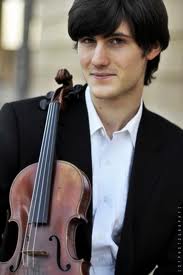|
Symphony
MYSTICAL PLANETS AND LIVELY GERSHWIN ORTIZ AT FINAL SRS CONCERT
by Peter Lert
Sunday, May 4, 2025
Symphony
VSO'S CONCERT MUSIC OF TIME, MUSIC OF PLACE
by Peter Lert
Sunday, April 27, 2025
Choral and Vocal
VOCAL ELEGANCE AND FIRE AT THE 222'S RECITAL APRIL 26
by Pamela Hicks Gailey
Saturday, April 26, 2025
CANTIAMO SONOMA SINGS AN INSPIRED GOOD FRIDAY MOZART REQUIEM CONCERT
by Pamela Hicks Gailey
Friday, April 18, 2025
DRAMATIC SHOSTAKOVICH SYMPHONY CLOSES PHILHARMONIC'S 25TH SEASON
by Terry McNeill
Sunday, April 13, 2025
LARGE COLLEGE OF MARIN AUDIENCE GREETS STOPHER ARTISTRY
by Terry McNeill
Saturday, April 5, 2025
Chamber
FRISSON DELIVERS SHIVERS OF DELIGHT
by Abby Wasserman
Sunday, March 30, 2025
OLD AND MOSTLY NEW IN SRS MARCH CONCERT IN WEILL
by Peter Lert
Saturday, March 22, 2025
Symphony
TWO FORMIDABLE SYMPHONIES AND PURPLE MOUNTAINS AT SRS CONCERT
by Peter Lert
Sunday, February 23, 2025
Chamber
THE PARKER CAPTURES DEMANDING ADES QUARTET AT RAC SEBASTOPOL CONCERT
by Peter Lert
Saturday, February 15, 2025
|
 |
 Violinist Nigel Armstrong |
ARMSTRONG BRINGS DOWN THE HOUSE
by Terry McNeill
Sunday, March 25, 2012
Local boy makes good was the operative theme March 26 when violinist Nigel Armstrong played a recital before a jammed Andrews Hall in downtown Sonoma, the event produced by the Sonoma Chamber Music Society. From Mr. Armstrong’s initial entrance with pianist Marilyn Thompson to a final raucous encore, the audience seemed to hang on every note and bodily movement of the young violinist.
The first half, consisting of Beethoven’s “Spring Sonata” and the Debussy Sonata, was problematical. Andrews Hall is not a kind acoustical space, with its high ceiling, plaster walls and surprisingly almost zero reverberation. The result was heavy piano dominance. Frequently one saw Mr. Armstrong’s flashing bow but not enough sound from him, especially in the scherzo and the finale (Rondo) pizzicato. Tempos in the Spring Sonata were moderate, the interpretation fluent and impressive in the long line of the Adagio, but on the whole a routine performance without special flair.
Debussy’s 1917 masterwork in G Minor, his last fully completed work, received some lovely playing that underscored its harmonic ambiguities. Mr. Armstrong’s soft playing in the opening Allegro Vivo was lovely, and in the high tessitura of the "Intèrmede" his vibrato widened but varied little, the ending soaring over a hushed crowd that included three rows of stage seats.
In a program change, the violinist skipped Ernst’s “Last Rose of Summer” variations and played the four-movement Ysäye solo Sonata No 2. Mr. Armstrong’s affinity with virtuoso works was on display in this composition, with many quotes from Bach (Third Partita) and the "Dies Irae" theme. The Sarabande was especially bouncy, the pizzicato and double stop effects performed with clean articulation. Mr. Armstrong played the "Les Furies" finale letting in a lot of air, the short motifs interrupted by rests and vigorously accented. It was a highlight of the afternoon.
Ms. Thompson then returned to the piano, whose lid had gone from short stick to no stick, and played Faure’s fetching Op. 75 Andante with the violinist. Instrumental balance had markedly improved, and the performance was sui generis Faure. Though rarely programmed, the piece is instantly recognizable, and it was performed without score, as were all the pieces in the second part. Faure's melancholic loveliness mated well with the following Tchaikovsky Op. 42 Melody, the third of three short pieces from an 1878 Suite the composer wrote at his patron’s country estate. The interpretation lacked rhythmic flexibility as musical schmaltz in the Melody is highly desirable!
Mr. Armstrong’s signature piece, Saint-Saëns’ "Introduction and Rondo Capriccioso," concluded the formal program. It was originally written for violin and orchestra, so the piano transcription is a daunting combination of fiery instrumental skips and slides for the fiddle, and it drew from the Ms. Thompson her most forceful and bass heavy playing of the program. A thunderous standing ovation was the result.
But Mr. Armstrong was not done yet, and in an encore anticipated by many in the hall he played Corigliano’s "Stomp." This solo work was commissioned by the 14th Tchaikovsky International Violin Competition in 2011, to be played by all competitors, with the sheet music received by each shortly before the Moscow Competition. It’s a whirlwind of dissonant notes and chopped phrases, and to everyone’s delight involved briefly playing the violin behind the back and resounding right-food stomps in various sequences. Intoxicating!
Needless to say, it brought down the house and the artist reveled in the warm affection and excitement his playing brought to his hometown fans.
Robert Hayden contributed to this review.
|
